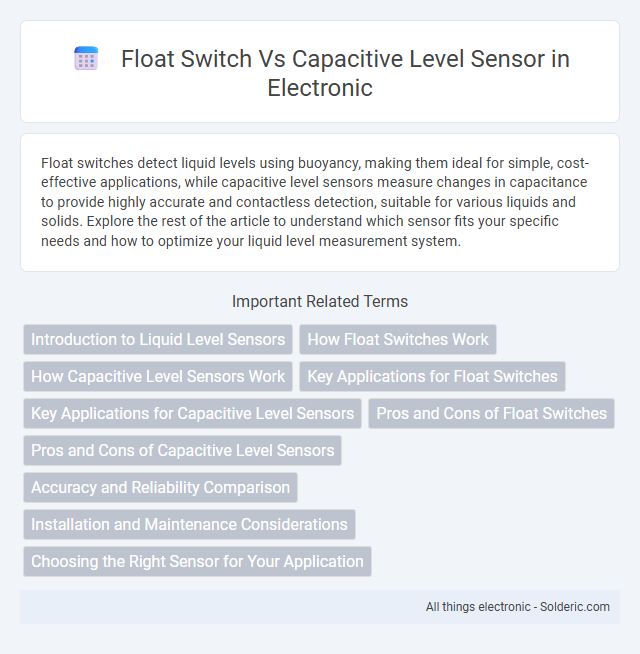Float switches detect liquid levels using buoyancy, making them ideal for simple, cost-effective applications, while capacitive level sensors measure changes in capacitance to provide highly accurate and contactless detection, suitable for various liquids and solids. Explore the rest of the article to understand which sensor fits your specific needs and how to optimize your liquid level measurement system.
Comparison Table
| Feature | Float Switch | Capacitive Level Sensor |
|---|---|---|
| Operating Principle | Mechanical float rises or falls with liquid level | Measures changes in capacitance caused by liquid level |
| Type of Liquid | Suitable for liquids with minimal turbulence, clean water, oils | Works with conductive and non-conductive liquids |
| Installation | Requires vertical mounting inside tank | Can be mounted externally or internally |
| Maintenance | Needs periodic cleaning to prevent mechanical failure | Low maintenance, no moving parts |
| Accuracy | Moderate accuracy, switch triggers at specific levels | High accuracy, continuous level measurement possible |
| Durability | Prone to wear and mechanical damage | Robust, resistant to harsh environmental conditions |
| Cost | Generally low cost | Higher initial cost |
| Applications | Simple level detection in tanks and sump pits | Industrial automation, chemical processes, food and beverage |
Introduction to Liquid Level Sensors
Liquid level sensors are critical devices used to detect and monitor the level of liquids within a container or system. Float switches operate by using a buoyant object that rises and falls with the liquid level, triggering a mechanical or magnetic switch, while capacitive level sensors utilize changes in capacitance caused by the presence or absence of liquid to provide continuous, non-contact measurement. These sensors are widely applied in industries such as water treatment, chemical processing, and food and beverage manufacturing for precise and reliable liquid level control.
How Float Switches Work
Float switches operate by using a buoyant object that rises and falls with the liquid level, triggering a mechanical or magnetic switch to open or close an electrical circuit. Your system can detect liquid presence or level changes as the float moves in response to the fluid's surface, providing reliable on/off signals for pumps or alarms. This simple, durable mechanism contrasts with capacitive level sensors, which measure changes in electrical capacitance to determine fluid level without physical contact.
How Capacitive Level Sensors Work
Capacitive level sensors operate by detecting changes in capacitance caused by the presence or absence of a material, such as liquids or solids, between their sensing electrodes. These sensors measure the dielectric constant variation to determine the level of the substance without physical contact, offering high accuracy and reliability in diverse applications. Compared to float switches, capacitive sensors provide maintenance-free operation and can detect both conductive and non-conductive materials in harsh environments.
Key Applications for Float Switches
Float switches are commonly used in water tanks, sump pumps, and wastewater treatment systems to monitor and control liquid levels. Their mechanical design makes them ideal for harsh environments where reliable, simple on/off level detection is required. You can rely on float switches for applications involving liquids with varying conductivity, such as oil, fuel, or chemicals, where capacitive sensors might face limitations.
Key Applications for Capacitive Level Sensors
Capacitive level sensors excel in applications requiring precise, continuous liquid level measurement in industries like food and beverage, pharmaceuticals, and chemical processing. Their non-contact sensing capability makes them ideal for detecting levels of viscous, corrosive, or dielectric fluids in tanks, silos, and pipelines. These sensors are preferred for monitoring corrosive chemicals, oils, and water-based solutions where float switches may suffer from mechanical wear or contamination.
Pros and Cons of Float Switches
Float switches offer reliable and cost-effective liquid level detection in tanks and reservoirs, making them ideal for simple applications with low maintenance requirements. Their mechanical design provides durability and easy installation but may face issues with moving parts prone to wear or damage in turbulent or corrosive liquids. Unlike capacitive level sensors, float switches do not provide continuous level measurement and have limited sensitivity in detecting non-conductive fluids or small liquid variations.
Pros and Cons of Capacitive Level Sensors
Capacitive level sensors offer precise, non-contact measurement of liquid levels, making them highly reliable for detecting a wide range of materials, including corrosive and viscous substances. They provide continuous level monitoring with minimal maintenance due to their solid-state design, but they can be sensitive to changes in dielectric constant and require careful calibration for accurate readings. Unlike float switches, capacitive sensors may have higher initial costs and can be affected by buildup on sensor surfaces, impacting long-term accuracy.
Accuracy and Reliability Comparison
Float switches offer reliable level detection in clean liquids but can suffer from mechanical wear and limited accuracy due to discrete on/off signals. Capacitive level sensors provide high accuracy with continuous level measurement and are less affected by liquid properties, ensuring consistent performance in diverse environments. These sensors typically deliver greater reliability and precise monitoring in industrial applications where continuous data is essential.
Installation and Maintenance Considerations
Float switches require straightforward installation, often involving simple mounting within the liquid tank, but they may need periodic cleaning to prevent mechanical sticking and ensure accurate operation. Capacitive level sensors offer non-contact detection with minimal wear and reduced maintenance, yet their installation demands proper calibration and consideration of tank material and dielectric properties for optimal performance. Both sensors' maintenance schedules are influenced by the liquid's properties and environmental conditions, impacting sensor longevity and reliability.
Choosing the Right Sensor for Your Application
Selecting between a float switch and a capacitive level sensor depends on factors such as liquid type, required precision, and environmental conditions. Float switches excel in simple, cost-effective applications with clear liquids, while capacitive sensors offer higher sensitivity and versatility for detecting various liquid levels, including non-conductive fluids. Your choice should align with the sensor's compatibility, durability, and accuracy needs to ensure optimal performance in your specific application.
Float switch vs capacitive level sensor Infographic

 solderic.com
solderic.com